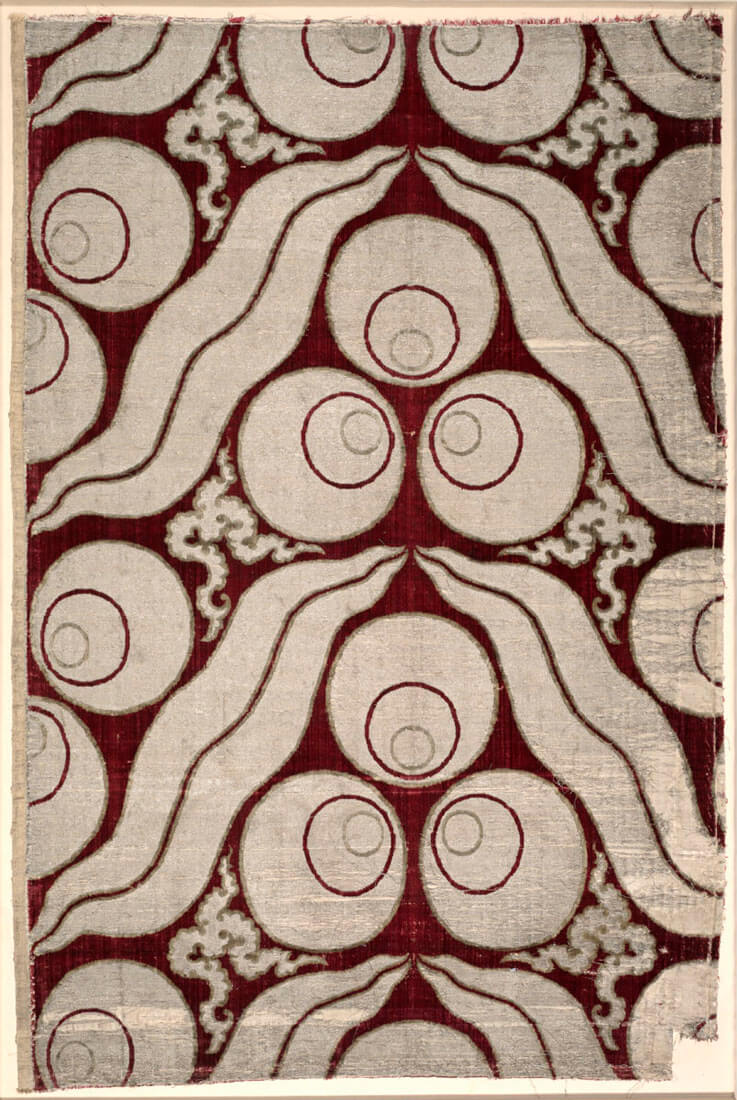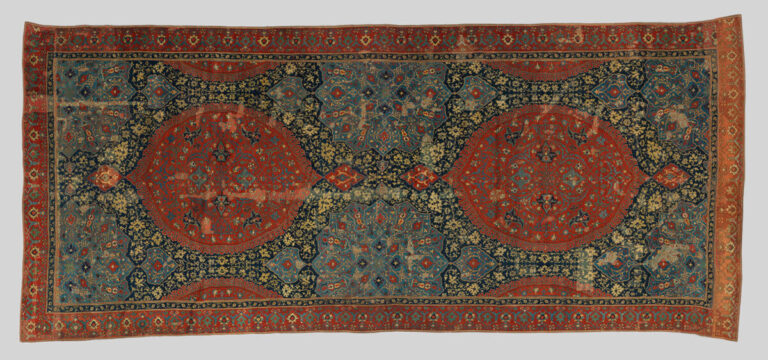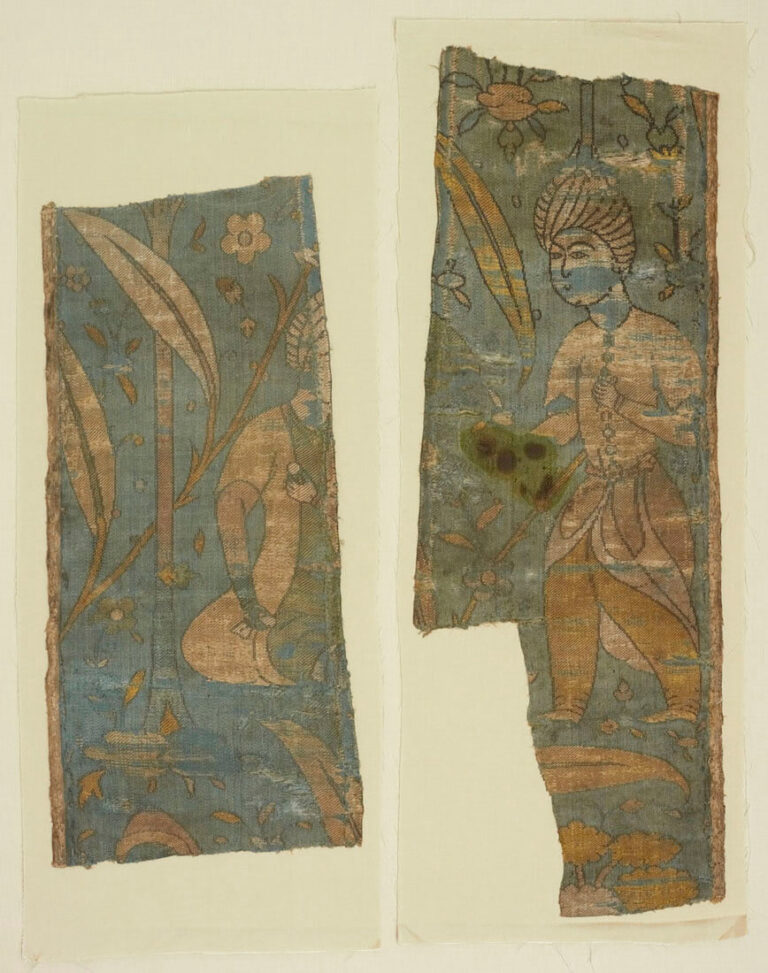Inv. no. LNS 219 T
Plain weave, undyed and embroidered in blue silk
Height 12 cm; width 18.5 cm
Egypt, early 10th century AD
early 4th century AH
Textiles & Rugs
Textiles are one of the most diverse types of objects from the Islamic lands. They include some of the most valuable and refined luxury goods produced, highly prized by their owners at the time and among the most prestigious diplomatic gifts and rewards for service at court. Egypt, Iran, Turkey and India produced some of the most spectacular woven textiles for garments and cushions, using silk and metal threads to luxurious effect in figural as well as calligraphic, floral and other designs.
In the early mediaeval period, Egypt was famous for ‘tiraz’ textiles, a series of types which incorporated inscription bands. Whether integrally woven, embroidered or written with pen and ink, these inscriptions generally took the form of fine calligraphy and often included the name of the Caliph and the factory (tiraz) in which they were produced.
Knotted pile carpets have a history in Asia which goes back beyond the fourth century BC. The Iranian lands and Turkey are justly famous for their production of carpets, with The al-Sabah Collection holding some two dozen fragments of 2nd – 4th centuries carpets from the region. These are in addition to many examples from later Islamic centuries. Thr distinctive ‘Mamluk’ carpets from 15th and early 16th centuries CE, Cairo are also well represented in the collection.

LNS 219 T
Fragment from a linen robe with a tiraz inscription invoking...

LNS 1094 T
Cotton shawl embroidered with vegetal designs and a lover’s lament...

LNS 1094 T
Cotton shawl embroidered with vegetal designs and a lover’s lament in Persian language (naskhi script) mentioning the city of Bamyan, in Afghanistan
Inv. no. LNS 1094 T
Plain weave, undyed, embroidered with dark-brown silk
Length 172 cm; width 44 cm
East Iranian world, 12th – early 13th century AD
6th – early 7th century AH
You can share this object via:

LNS 443 T
Silk panel from a garment with pairs of sphinxes, and...

LNS 443 T
Silk panel from a garment with pairs of sphinxes, and a repetition of the word ‘glory’ in Kufic script along the upper edge
Inv. no. LNS 443 T a
Lampas weave with silver thread
Height 109 cm; width 50.3 cm
East Iranian world, ca. 12th century AD
ca. 6th century AH
You can share this object via:

LNS 34 T
Fragmentary silk textile composed as a series of horizontal bands,...

LNS 34 T
Fragmentary silk textile composed as a series of horizontal bands, alternating between naskhi inscriptions in cartouches (‘Everlasting happiness and steadfast glory [to its owner]’), quadrupeds, angular guilloches, and medallions with geometric star roundels on a ground of half-palmette designs
Inv. no. LNS 34 T
Lampas weave with metal threads
Height 45.5 cm; width 27 cm
Spain, 14th – 15th century AD
8th – 8th century AH
You can share this object via:

LNS 13 R
Woollen carpet of geometric layout, featuring a large eight-pointed star,...

LNS 13 R
Woollen carpet of geometric layout, featuring a large eight-pointed star, with borders of cartouches alternating with octagons, field and border incorporating myriads of geometric figures of the 90° system and papyrus plant motifs
Inv. no. LNS 13 R
Dyed, woven, and knotted (pile)
Length 437 cm; width 268 cm
Egypt, early last third 15th – beginning 16th century AD
early last third 9th – beginning 10th century AH
You can share this object via:

LNS 11 T
Silk velvet textile fragment in a pattern of staggered rows...

LNS 11 T
Silk velvet textile fragment in a pattern of staggered rows of triangular groups of three circles (‘leopard spots’), separated by paired undulating ‘tiger’ stripes; ‘Chinese cloud scrolls’ in the interstices
Inv. no. LNS 11 T
Brocaded and voided velvet with metal thread
Height 88 cm; width 59 cm
Turkey, mid 16th century AD
mid 10th century AH
You can share this object via:

LNS 98 T
Linen textile panel embroidered in a pattern of tulips and...

LNS 98 T
Linen textile panel embroidered in a pattern of tulips and serrated lotuses, square plan of repetition; serrated leaves fill the interstices and the border
Inv. no. LNS 98 T
Plain linen embroidered with silk
Height 190 cm; width 132 cm
Turkey, late 17th century AD
late 11th century AD
You can share this object via:

LNS 119 T
Silk velvet textile fragment in a pattern of staggered rows...

LNS 119 T
Silk velvet textile fragment in a pattern of staggered rows of carnation flower-heads, with serrated leaves and diminutive trees in the interstices
Inv. no. LNS 119 T
Brocaded and voided velvet with metal thread
Height 156 cm; width 123 cm
Turkey, early 17th century AD
early 11th century AH
You can share this object via:

LNS 26 R
Woollen carpet, the field with staggered rows of ogival and...

LNS 26 R
Woollen carpet, the field with staggered rows of ogival and stellate medallions, the interstices densely filled with foliate and floral motifs; border of half-palmette arabesque enclosing flower-heads
Inv. no. LNS 26 R
Dyed, woven, and knotted (pile)
Length 726 cm; width 320 cm
Western Anatolia, ca. 1st half 16th century AD
ca. 1st half 10th century AH
You can share this object via:

LNS 15 R
Woollen “Shrub” carpet, the field of horizontal orientation, both the...

LNS 15 R
Woollen “Shrub” carpet, the field of horizontal orientation, both the field and border with rows of a variety of flowering plants (those of the field staggered, those of the border forming a single straight line)
Inv. no. LNS 15 R
Warp and weft of cotton, pile of wool
Height 279 cm; width 508 cm
Northern India, later (?) 17th century AD
later (?) 11th century AH
You can share this object via:

LNS 10 R
Pile carpet laid out as a four-section garden (Persian, chahar...

LNS 10 R
Pile carpet laid out as a four-section garden (Persian, chahar bagh) with representations of flowering trees and flower beds, divided by water channels, and with a central pond with four peacocks
Inv. no. LNS 10 R
Warp and weft of cotton, pile of wool
Length 925 cm; width 380 cm
North-west or Central Iran, early 18th century AD
early 12th century AH
You can share this object via:

LNS 114 T
Talismanic shirt with decorative roundels, escutcheons and a cartouche filled...

LNS 114 T
Talismanic shirt with decorative roundels, escutcheons and a cartouche filled with pious inscriptions in naskhi and attenuated thuluth, square compartments with the complete text of the Qur’an, and borders with the ninety-nine ‘Beautiful Names’ (al-Asma’ al-Husna) of God
Inv. no. LNS 114 T
Ink and colours on cotton
Height 50 cm; width 92.5 cm
India, probably late 15th century AD
probably late 9th century AH
You can share this object via:

LNS 27 R
Fragmentary multiple-niche pile prayer carpet (saff), the lower fields of...

LNS 27 R
Fragmentary multiple-niche pile prayer carpet (saff), the lower fields of the niches with a dense composition of two systems of foliated scrolls, the spandrels of the niches with a composition of half-palmettes and flowers on spiralling stems; preserved main border with an alternation of cartouches and four-lobed compartments filled with floral and half-palmette arabesques
Inv. no. LNS 27 R
Warp of cotton, weft and pile of wool
Length 153 cm; width 260 cm
Iran, 2nd half 16th century AD
2nd half 10th century AH
You can share this object via:

LNS 982 T a
Linen, silk and silver wire textile fragment with rows of...

LNS 982 T a
Linen, silk and silver wire textile fragment with rows of affronted birds framing a human face, running hares and dotted rosettes
Inv. no. LNS 982 T a
Tapestry weave, dyed
Height 18.5 cm; width 61 cm
East Iranian world, 12th – early 13th century AD
6th – early 7th century AH
You can share this object via:

LNS 14 T a,b
Two fragments from the same silk textile (from a garment...

LNS 14 T a,b
Two fragments from the same silk textile (from a garment or furnishings?), featuring a seated prince and an attendant in a landscape setting
Inv. no. LNS 14 T a,b
Lampas weave
Height (a) 37 cm; width 17 cm; height (b) 48.5 cm, width 17 cm
Iranian world, 16th century AD
10th century AH
You can share this object via:
